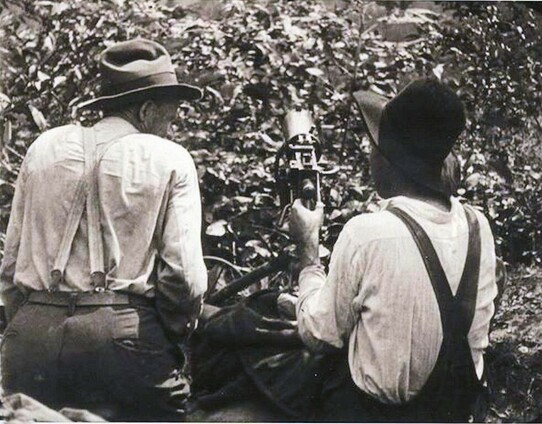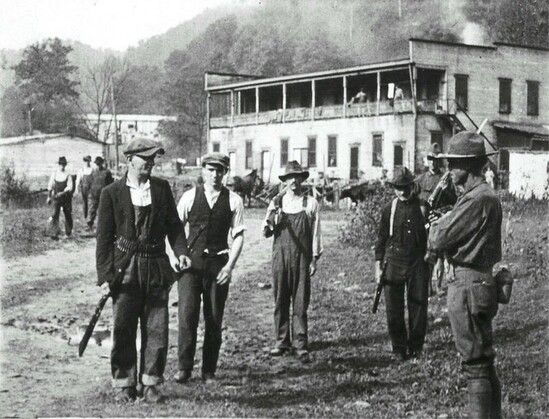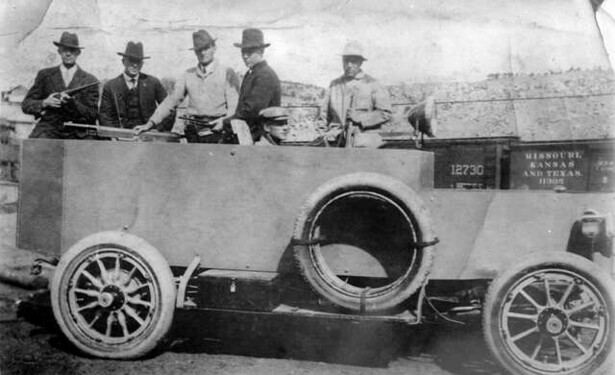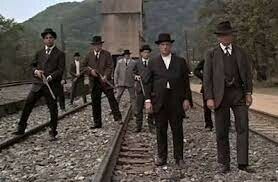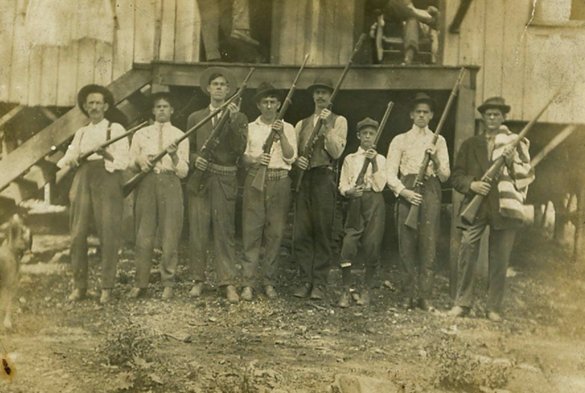MikeDunnAuthor · @MikeDunnAuthor
1901 followers · 4062 posts · Server kolektiva.socialToday in Labor History September 2, 1921: The Battle of Blair Mountain ended on this date in 1921, with the U.S. government bombing striking coal miners by plane, the second time the U.S. government used planes to bomb its own citizens (the first was in the Tulsa riots, earlier that year). The Battle of Blair Mountain was one of the largest civil uprisings in U.S. history and the largest armed insurrection since the Civil War. The uprising lasted 5 days and involved 10,000-15,000 coal miners confronting an army of scabs and police. The battle came as mine owners tried to crush attempts by coal miners to unionize the southwestern West Virginia coalfields. From the late 1800s, mine owners forced workers to live in company towns, where rent was deducted from their wages and they were paid in scrip, which was accepted only at the overpriced company stores and was worthless everywhere else. The work was very dangerous and safety equipment and precautions were minimal. The mine owners had a long tradition of using private detectives and goons to spy on workers, infiltrate their meetings, rough them up, and block any attempts to unionize. The battle began after Sheriff Sid Hatfield (an ally of the miners and hero from the Battle of Matewan) was assassinated by Baldwin-Felts agents. Much of the region was still under martial law as a result of the Battle of Matewan. Miners began to leave the mountains armed and ready for battle. Mother Jones tried to dissuade them from marching into Logan and Mingo Counties, fearing a bloodbath. Many accused her of losing her nerve. The miners ignored her and a battle ensued between miners and cops, private detectives, scabs and eventually the U.S. military.
#WorkingClass #LaborHistory #coal #mining #strike #union #BlairMountain #WestVirginia #matewan #police #PoliceBrutality #massacre #PoliceMurder #Riot #MotherJones
#workingclass #LaborHistory #coal #mining #strike #union #blairmountain #westvirginia #matewan #police #policebrutality #massacre #policemurder #Riot #motherjones
MikeDunnAuthor · @MikeDunnAuthor
1850 followers · 3937 posts · Server kolektiva.socialToday in Labor History August 21, 1920: Ongoing violence by coal operators and their paid goons in the southern coalfields of West Virginia led to a three-hour gun battle between striking miners and guards that left six dead. 500 Federal troops were sent in not only to quell the fighting, but to ensure that scabs were able to get to and from the mines. A General Strike was threatened if the troops did not cease their strikebreaking activities. This was just 3 months after the Matewan Massacre, in which the miners drove out the seemingly invincible Baldwin-Felts private police force, with the help of their ally, Sheriff Sid Hatfield. 1 year later, Sheriff Hatfield was gunned down on the steps of the courthouse by surviving members of the Baldwin-Felts Agency. News spread and miners began arming themselves, leading to the Battle of Blair Mountain, the largest armed insurrection since the Civil War and the largest labor uprising in U.S. history. Over 100 people were killed in the 5-day battle, including 3 army soldiers and up to 20 Baldwin-Felts detectives. Nearly 1,000 people were arrested. 1 million rounds were fired. And the government dropped bombs from aircraft on the miners, only the second time in history that the government bombed its own citizens (the first being the pogrom against African American residents of Tulsa, during the so-called Tulsa Riots).
The Battle of Blair Mountain is depicted in Storming Heaven (Denise Giardina, 1987), Blair Mountain (Jonathan Lynn, 2006), and Carla Rising (Topper Sherwood, 2015). And the Matewan Massacre is brilliantly portrayed in John Sayles’s film, “Matewan.”
#WorkingClass #LaborHistory #mining #strike #union #WestVirginia #matewan #BattleOfBlairMountain #uprising #CivilWar #GeneralStrike #tulsa #massacre #racism #books #fiction #film #writer #author #novel @bookstadon
#workingclass #LaborHistory #mining #strike #union #westvirginia #matewan #battleofblairmountain #uprising #civilwar #generalstrike #tulsa #massacre #racism #books #fiction #film #writer #author #novel
MikeDunnAuthor · @MikeDunnAuthor
1406 followers · 3093 posts · Server kolektiva.socialToday in Labor History June 22, 1914: Anarchists, intending to bomb the Rockefeller Mansion, accidentally blew up the Ferrer Center for anarchist education, killing three anarchists and putting a temporary end to the Modern School. They had been seeking revenge against Rockefeller’s Standard Oil for the Ludlow Massacre (4/20/1914), in which Colorado National Guards and private cops, hired by Rockefeller, attacked a tent colony of 1,200 miners and their families, killing 21, including women and children. The private cops were from the Baldwin-Felts Detective Agency, same ones involved in the Matewan Massacre in West Virginia. From September 1913 through end of May, 1914, up to 200 people had died in the Colorado Coalfield War, including 37 cops, soldiers and private detectives fighting for the coal companies, making it one of the deadliest strikes in U.S. history.
#WorkingClass #LaborHistory #colorado #mining #anarchism #ModernSchool #FranciscoFerrer #rockefeller #union #strike #massacre #ludlow #matewan #cops #PoliceBrutality #police
#workingclass #LaborHistory #colorado #mining #anarchism #modernschool #franciscoferrer #rockefeller #union #strike #massacre #ludlow #matewan #cops #policebrutality #police
MikeDunnAuthor · @MikeDunnAuthor
1305 followers · 2938 posts · Server kolektiva.socialToday in Labor History May 18, 1920: The Battle of Matewan occurred in the town of Matewan, Mingo County, West Virginia. It started when the mine bosses fired miners for joining the United Mine Workers of America (UMWA) and evicted them from their company housing. Sheriff Sid Hatfield supported the miners’ right to organize and tried to arrest the detectives. The detectives, in turn, tried to arrest Hatfield. Unbeknownst to the detectives, armed miners had surrounded them. No one knows who shot first, but when the smoke had cleared, there were 7 dead detectives, including Albert and Lee Felts, and 4 dead townspeople, including the mayor. The episode became known as the “Matewan Battle” or “Matewan Massacre,” and is depicted in John Sayles’ film Matewan.
It should be pointed out that mining was one of the most dangerous and corrupt industries around. Owners typically forced the miners to live in company towns and purchase living necessities from their company stores at inflated prices. They paid the men in scrip, which was useless outside of the company towns. In the time leading up to the Battle of Matewan, miners in other parts of the country had won a 27% wage increase. The time was ripe for organizing southern Appalachia. The UMWA sent in their best organizers, including Mother Jones. 3,000 men signed union cards in the early spring of 1920. Yet, at the same time, vigilantes, detectives and goons were murdering miners in the region. And the company was evicting anyone who signed up. So, hundreds of miners and their families were living in the Stony Mountain Camp Tent Colony.
In order to quell the violence, the governor sent in the state police to take control of Matewan. Hatfield cooperated. And the miners, encouraged by the departure of the Baldwin Thugs, increased their organizing efforts. On July 1, they went on strike again and were met with even more violence. Striking miners were beaten and left to die in the streets. And the remaining Felts brother, Tom, instigated a vendetta against Sheriff Hatfield, eventually having him killed by his agency in 1921.
#WorkingClass #LaborHistory #matewan #miners #strike #union #massacre #film #acab #Detectives
#workingclass #LaborHistory #matewan #miners #strike #union #massacre #film #acab #Detectives
Wonkette Headline Bot · @wonkette_bot
872 followers · 1741 posts · Server wonkodon.comWhen The Matewan Miners, Mayor, And Police Chief Faced Off Against The Mines' Gun Thugs https://www.wonkette.com/when-the-matewan-miners-mayor-and-police-chief-faced-off-against-the-mines-gun-thugs
#West_virginia #Matewan #May_19_in_labor_history #United_mine_workers_of_america #John_l_lewis #Baldwinfelts_agents #John_sayles #Men_with_guns #Today_in_labor_history
#Today_in_labor_history #Men_with_guns #John_sayles #Baldwinfelts_agents #John_l_lewis #United_mine_workers_of_america #May_19_in_labor_history #matewan #west_virginia
Ted Pedersen (he/him) · @SeeTedTalk
295 followers · 163 posts · Server dair-community.social@workingclasshistory The movie #Matewan remains one of my favorites ...
https://www.imdb.com/title/tt0093509/
MikeDunnAuthor · @MikeDunnAuthor
697 followers · 1195 posts · Server kolektiva.socialToday in Labor History February 7, 1913: A county sheriff and his deputies on the “Bull Moose Special” (an armored train fitted with machine guns), attacked a miners’ tent colony at Holly Grove, in West Virginia. This was during the Paint Creek-Cabin Creek Strike (4/18/1912 through July 1913). Mother Jones was one of the main organizers. Over 50 people died during the violent confrontations with scabs, goons and private detectives. Countless more died from starvation and malnutrition. In terms of casualties, it was one of the worst strikes in U.S. history. It was a prelude to the bigger and even more violent Battle of Matewan, and the Battle of Blair Mountain (Aug-Sep, 1921). The latter was the largest labor uprising in U.S. history, and the largest armed insurrection since the Civil War. 10,000 minors battled 3,000 lawmen and scabs, and only ended with the U.S. army intervened. Up to 100 people died. And during the battle, bombs were dropped on the striking miners by airplane, the 2nd time in U.S. history that had been done. (The first was just months earlier, during the Tulsa Race Massacre).
#workingclass #LaborHistory #motherjones #coal #mining #massacre #bombing #matewan #westvirginia #machineguns #scabs #strike #police #army #insurrection #civilwar
#workingclass #LaborHistory #motherjones #coal #mining #massacre #bombing #matewan #westvirginia #machineguns #scabs #strike #police #army #insurrection #civilwar
Tucker Teague · @tuckerteague
1090 followers · 1157 posts · Server mastodon.socialMore films from the director #JohnSayles ought to be available for #streaming. He's a great filmmaker and an important voice.
Consider this a #PSA
Many of these films are hard to find and most are not streaming at all:
#ReturnoftheSecaucusSeven
#Lianna
#BabyIt'sYou
#TheBrotherfromAnotherPlanet
#Matewan
#EightMenOut
#CityofHope
#PassionFish
#TheSecretofRoanInish
#LoneStar
#MenwithGuns
#Limbo
#SunshineState
#CasadelosBabys
#SilverCity
#Honeydripper
#Amigo
#GoforSisters
#johnsayles #streaming #psa #returnofthesecaucusseven #lianna #babyit #thebrotherfromanotherplanet #matewan #eightmenout #cityofhope #passionfish #thesecretofroaninish #lonestar #menwithguns #limbo #sunshinestate #casadelosbabys #silvercity #honeydripper #amigo #goforsisters
Matt Noyes · @Matt_Noyes
508 followers · 8571 posts · Server social.coopJust watched #Matewan with @chiematsumoto
"That's what a union is, fellas, you better get used to it."
